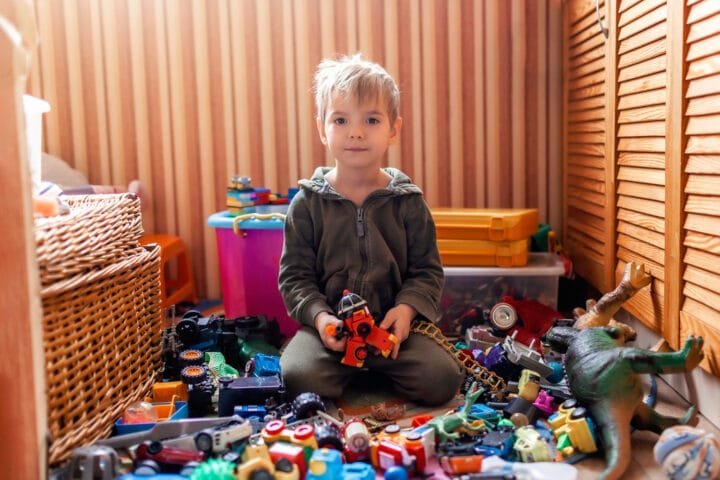How to Homeschool Kindergarten: Your Ultimate Guide for an Engaging Experience
Are you contemplating the possibility of homeschooling kindergarten at home or just starting this exciting adventure? Welcome! Homeschooling can be manageable as well as enjoyable with the right method and arrangement. This guide will explain all you should be aware of when it comes to homeschooling kindergarten, making it a pleasurable and rewarding experience for you and your child.

Why Homeschool Kindergarten?
Kindergarten at home offers more than just academic learning. It provides a stimulating environment in which your child will be able to flourish and realize their full potential. Many parents choose to teach their children at home because it lets them tailor the learning experience to the child’s specific requirements and interests. Imagine watching your child glow with enthusiasm when they learn new concepts – that’s the joy of homeschooling!
Then, why do more parents choose to have their kids homeschooled? Here are a few convincing motives:
- Personalized Learning: Homeschooling lets you tailor the curriculum to meet your child’s style of learning and passions. If your child is obsessed with dinosaurs, it is possible to integrate them into lessons in math, reading, and science, making learning enjoyable and interesting.
- Flexible Scheduling: When you homeschool, you can design the schedule that best suits the lifestyle of your family. If your child is more successful learning in the morning or just after an afternoon nap, you can create an arrangement that is suitable for both you and your child.
- Stronger Families Bonds Kindergarten at home gives you more time to spend together with children, enhancing relationships between the family while allowing your child to become an integral element in their learning.
- Secure Learning Environment The homeschooling method provides a safe and controlled environment free of the tensions and distractions that can be found in the traditional classroom, which allows your child to study in a safe and comfortable environment.
The number of students who attend homeschooling has grown significantly over the last few years. As per the U.S. Census Bureau, approximately 6.5 percent of families with children in school reported having homeschooled in 2023. This is a significant increase from prior years. The growing demand for alternative methods of education, driven by the COVID-19 virus, has prompted many parents to keep their children homeschooled regardless of the fact that schools are reopening.
In addition, research conducted by the National Home Education Research Institute (NHERI) has shown that students who are homeschooled typically have a higher score of 15-30% on tests that are standardized than their public school counterparts regardless of the parents’ degree or formal training.
How to Homeschool Kindergarten: Getting Started
Beginning your journey to homeschool kindergarten can be daunting; however, with the right preparation, you’ll be set to start. Here’s a quick guideline for how to homeschool kindergarten with success:
- Set Up Your Learning Space: Choose a quiet, well-lit area in your home as your “classroom.” It doesn’t need to be a whole room, but just the space in which your child can concentrate. Organise it with educational materials such as books as well as art tools, manipulatives as well as technology.
- Select a Curriculum: Choosing the appropriate curriculum is crucial to homeschooling kindergarten successfully. Find resources that are fun and flexible, as well as aligned with your child’s needs and learning approach. A well-designed kindergarten curriculum must include writing, reading, science, math, and social studies. It should encourage exploration and creativity.
- Make a Plan: Although homeschooling is flexible, a regular schedule helps to provide structure and stability. Set up a schedule for the day that allows for play and rest. For children in kindergarten, small, focused lessons with breaks between them are ideal.
How to Homeschool Kindergarten: Building an Engaging Curriculum
A stimulating curriculum is crucial to a positive homeschool experience. If you are planning to homeschool your child in kindergarten, take a look at the topics that your child must master and then teach the lessons in a stimulating manner. Here’s a list of the most important subjects, along with suggestions for creative ways to teach them:
- Literacy and writing: Begin with the basics, such as alphabet recognition and phonics. Engage your child in fun, interactive activities such as alphabet games, stories, and songs to help reinforce the learning process. As your child develops, begin to introduce writing and reading exercises that are in line with their interests.
- Math Magic: Bring math to life through activities that transform everyday moments into opportunities for learning. Make use of toys to count and play games involving making shapes or baking in order to teach fractions and measurements. Puzzles, blocks, and math tales make numbers enjoyable and real.
- Science Adventures: Boost your curiosity by exploring the natural world. Make easy science-based experiments. Watch the weather patterns or study the life cycle of animals and plants. Utilize nature walks, gardening, and cooking experiments as enjoyable learning opportunities to impart the basics of science and create curiosity.
- Cultural Studies as well as Culture Let your child explore the world by studying diverse communities, cultures, and their traditions. Make use of globes, maps, and stories from all over the globe as teaching tools. Take advantage of international celebrations. Taste cuisines from different countries or make artwork that is inspired by other styles of living to make social studies a thrilling experience.
- Music and Art: Encourage imagination by having regular music and art classes. Your child will be provided with tools such as crayons, paints, clay, and repurposed items to create projects. Introduce them to a variety of musical instruments, songs, and rhythms that allow them to be themselves and explore.
- Physical Education Physical Activity is important for children in their early years. Include activities that are routine, such as yoga, dancing, or even simple exercises, into your daily routine. It is important to go out to the park for walks or play and visit parks to ensure your child is getting plenty of oxygen and movement.
As per the Centers for Disease Control and Prevention (CDC), children aged 3-5 must engage in a variety of physical activities throughout the day in order to aid their children’s growth and development. This advice is compatible with homeschooling, in which parents are able to include fun physical activities in their routine learning programs.

How to Homeschool Kindergarten: Fun Teaching Strategies
Engaging your child in learning takes a lot of creativity, patience, and determination. Here are some ways to teach your child at home kindergarteners:
- Learn hands-on. Children learn best through doing. Include activities that require the use of hands, movements, and manipulation. Playdough, for instance, can be used to create numbers and letters or build a miniature garden to introduce children to plants and the natural world.
- Role Play and Storytelling: Children love stories and role games. Utilize storytelling and role-play to make lessons more relatable and enjoyable. Perform historical scenes, make up imaginary worlds, or make use of puppets to make stories come alive. This method is not just fun for children but also aids in developing social and language abilities.
- Educational Games: Transform learning into playing. Play cards, board games, and online games for education to reinforce your concepts in a fun and engaging way. Games can improve your memory, concentration, and critical thinking while making learning seem like a game.
- Tech Integration in the current digital age online, educational apps, and resources can be beneficial tools to homeschool your children. Make use of interactive apps for subjects such as math, reading, and science. Online platforms such as Khan Academy Kids and ABCmouse offer games, lessons, and activities designed specifically for children.
- Field Trips and Real-world Learning Experience: Learning away from the comfort of your home by taking field trips to museums, parks, zoos, and historic places. These field trips offer interactive learning experiences that cannot be duplicated in traditional classrooms. Your child should be encouraged to inquire, observe, and be involved with the environment.
Research suggests that learning through experiential learning — which is by doing and reflecting can significantly improve a child’s understanding and retention of knowledge. A 2022 study conducted by the National Association for the Education of Young Children (NAEYC) discovered that children who participate in activities that require hands-on learning enhance their critical thinking skills and perform better academically over those who rely only on classroom instruction in the traditional way.
How to Homeschool Kindergarten: Socialization and Extracurriculars
The most commonly held belief concerning homeschooling is that it hinders social interaction. In reality, homeschooling gives numerous chances for kids to connect with others and engage in extra-curricular events. Here’s how you can homeschool kindergarten to ensure that your child is getting plenty of social interaction
- Participate in Homeschool Groups and Co-Ops: Many communities with homeschooling groups and co-ops organize regular gatherings, classes, and field excursions. These groups offer structured social opportunities as well as a chance for children to play and learn with other children.
- Organise playdates and group activities. Plan playdates with your neighbors, friends, or other families who homeschool. Plan group activities, such as art classes, sports, or science clubs, to provide your child with the opportunity to meet new people and build social skills.
- Participate in community events. Participate in local community events like story time at the library or festivals, as well as volunteering opportunities. These events are a fantastic opportunity for your child to engage with a variety of people and gain knowledge about the community they live in.
- Participating in extracurricular activities such as dance music, martial arts, music, and team sports gives more social opportunities and helps children learn new abilities. Numerous organizations offer classes designed for children who are homeschooled.
- Make use of online communities and virtual Classes: In this digital age, there’s a myriad of virtual and online communities for children who are homeschooled. These websites offer the opportunity to interact with other kids and participate in group activities or even take virtual field excursions.
A report for 2021 from the U.S. Department of Education indicated that students who are homeschooled participate in an average of 5.2 extracurricular activities each week, in comparison to 3.4 activities for traditional schooled kids. This data shows that children in homeschooling have ample opportunities to interact with others and discover their passions beyond a formal school environment.

How to Homeschool Kindergarten: Monitoring Progress and Celebrating Achievements
The ability to track your child’s progress over time is an important aspect of homeschooling. It lets you know what’s working, which needs adjustments, and the way your child is growing. Here’s How to Homeschool Kindergarten with a successful progress monitor:
- Informal Assessments: Utilize everyday activities to assess your child’s comprehension. Inquire about their activities and engage in discussions about the lessons they’re absorbing. The feedback you receive from them can help you determine strengths and areas that require more attention.
- Formal Evaluations: At times, you can make use of more structured assessments such as worksheets, quizzes, and assignments to assess your child’s progress. Make sure that these evaluations are easy and enjoyable. Remember, it’s about learning not to cause stress.
- Portfolios and Progress Logs keep the portfolio of your child’s work with writing examples, drawings, projects, and pictures of the things that they have done. Keep a log of progress to record milestones and accomplishments. These records are the ability to observe changes over time. They can be passed along to family members and acquaintances to celebrate achievements.
- Celebrate Successes: Recognize and honor your child’s achievements, both big and small. Make use of stickers, praise or certificates, or even small rewards to encourage and inspire your child. Recognizing their achievements boosts confidence and inspires a passion for learning.
How to Homeschool Kindergarten: Overcoming Challenges
Every homeschooling adventure includes ups and downs. Here are some of the most common issues and suggestions on How to Homeschool Kindergarten in a way that you can overcome these challenges:
- Maintaining Motivation: Parents, as well as children, may experience fatigue or lack of motivation. Make sure you’re changing up your routine, experimenting with new ways of doing things, and taking breaks as required. Keep in mind that it’s normal to take a break from work, but what’s most important is getting back to your routine.
- The management of time Balance homeschooling with other obligations can be a challenge. Plan a flexible schedule that can accommodate unexpected interruptions and changes. Prioritize your tasks and utilize tools like timers and planners to stay on top of things.
- How to handle resistance: It’s common for children to be resistant to certain subjects or activities. When your kid is having trouble with resistance, you can try another method or break and come back later to revisit the subject. Discover ways of making learning enjoyable by incorporating your child’s passions.
- Finding opportunities for social interaction: Making sure your child is getting sufficient social interactions is challenging, particularly for those who live in remote locations. Make sure you are actively seeking opportunities to connect with others via local groups or extracurricular activities, as well as online communities. Be open to thinking beyond the norm and make your own experiences in socializing.
- Becoming in compliance with the laws governing homeschooling can be overwhelming. Stay informed by regularly checking the regulations of your state, attending seminars on homeschooling, and connecting with local support groups to get assistance and information.
Resources for Homeschooling Kindergarten
The right tools can make all the impact on your homeschooling experience. Here are a few essential tools and resources to aid you in starting your homeschooling journey:
- Workbooks and Books Consider investing in foundational books, such as “The Read-Aloud Handbook” by Jim Trelease and “What Your Kindergartener Needs to Know” by E.D. Hirsch Jr. These guides provide helpful guidance on the essential skills and knowledge for students in the early years.
- Educational Equipment: Fill your homeschool space with educational supplies such as Magnetic letters, Math Manipulatives, Calendar For Kids, Kindergarten Math Workbook, 16 Educational Posters for Classroom & Kindergarten, Grips for Kids Handwriting Pencil, Modern Arts and Crafts Kit, and educational toys. Companies such as Melissa & Doug offer a large selection of high-quality educational tools that are hands-on and interactive.
- Internet Platforms: Sites such as Khan Academy Kids, ABCmouse, and Starfall provide low-cost or free lesson activities, games, and lessons that are designed specifically for children who are in kindergarten. These platforms provide structured, interactive, and engaging content that is a perfect complement to the curriculum for homeschooling.
- Community Resource: You should remember the resources you have in your local area. Zoos, museums, libraries, and parks usually provide educational programs, events, and activities that will improve your homeschooling education.
If you’re interested in valuable parenting tips and resources. Check out our latest posts at Mamawithlove:
- Do Kids Need to Go to Preschool? A Comprehensive Guide for Parents
- Review of “How to Talk So Kids Will Listen” by Adele Faber and Elaine Mazlish
- Unlock Your Child’s Potential: The Must-Know Life Skills to Teach Kids!
- 5 Essential Tips to Determine What the Reading Level for Kindergarten Should Be
- Is My Kid Dumb Because He Goes to Half Day Kindergarten?

Conclusion: Embrace the Homeschooling Journey
Kindergarten at home is an amazing chance to design a unique and enjoyable educational environment for the child. Suppose you know how to homeschool kindergarten using the right methods, resources, and mental attitude to create an interest in learning that will last throughout the years. Keep in mind that homeschooling isn’t solely about academics. It’s about cultivating your child’s interest, creativity, and confidence.
When you begin this thrilling journey, be flexible, keep your mind on the right track, and relish the precious moments of learning and development together with your kid. With perseverance, dedication, and a touch of creativity, you’ll realize that homeschooling your child could be among the most satisfying moments for both you and your child. Explore, dive in, and enjoy the best of this amazing adventure!
References
- (2016). September Is National Food Safety Education Month. FEW's News, 48(5), 3.
- Can You Get Herpes In Your Eyes?
- The Power of 24-Hour Movement Guidelines to Improve Your Health - Core Kinesis Physiotherapy.
- Education – Hotel Bal.
- The Importance of Self-Care - Ferndown Massage.
- Empower Your 2024 New Year's Healthy Eating Goals with Whole Foods and Support System - Happy New Year 2024 Wallpapers.
- Unlocking the Global Market: Strategies for International Film Distribution | Dylan Sidoo.
- Finding an Affordable Way to Further Your Kid’s Education in the Tech Age - Koupon Karen.
- A Comprehensive Guide: How to Franchise Your Business Successfully |.
- Creating a Successful Home Preschool: A Guide to Preschool at Home Schedule - Teaching Littles.
- How To Explain Time To A Child - Star Language Blog.
- The Power of 24-Hour Movement Guidelines to Improve Your Health - Core Kinesis Physiotherapy.
- Taylor, T. (2013). Coloring Outside The Lines: An Intersectionality Approach To Understanding The Homeschooling Experiences of Black Families.





































































